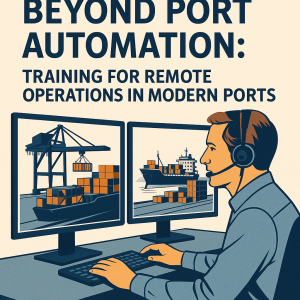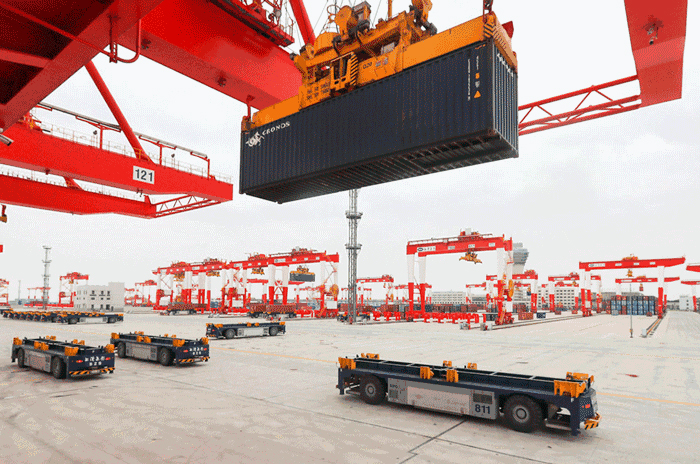The maritime industry is undergoing a digital revolution, with automation and remote operations transforming traditional port activities. While automation has significantly improved efficiency, the next frontier is remote operations, where port personnel manage critical processes from control centers miles away from the physical port.
However, the shift to remote operations requires more than just advanced technology—it demands specialized training programs to equip workers with the skills needed to oversee automated systems, troubleshoot issues remotely, and ensure seamless port operations. By the end of this article, you’ll understand why training is the backbone of successful remote port operations and how ports worldwide are preparing for this shift.
The Evolution from Port Automation to Remote Operations
Port automation (e.g., AGVs, remote cranes) improved efficiency but still required on-site supervision. Now, remote operations enable off-site control centers using 5G, IoT, and AI. Ports like Rotterdam and Singapore are testing remote cranes and AI-driven maintenance, but workforce training is critical for this shift.
Port automation began with Automated Stacking Cranes (ASCs), Automated Guided Vehicles (AGVs), and Remote-Operated Ship-to-Shore (STS) cranes. These technologies reduced human intervention in repetitive tasks, improving efficiency and safety. However, automation alone doesn’t eliminate the need for human oversight—operators still monitor systems from control rooms within the port.
Remote operations take automation further by allowing centralized control centers located off-site. Operators can:
- Monitor multiple terminals from a single location
- Respond to incidents in real-time via IoT sensors and AI analytics
- Reduce on-site personnel while maintaining (or improving) efficiency
Ports like Rotterdam, Singapore, and Shanghai are already experimenting with remote-controlled cranes and unmanned vessels. But this transition requires new skill sets that traditional port workers may not possess.
Key Challenges in Transitioning to Remote Operations
Major hurdles include workforce resistance (fear of job loss), cybersecurity risks (hacking, data breaches), connectivity issues (5G failures), and regulatory compliance. Solutions involve upskilling programs, cybersecurity training, backup protocols, and regulatory education.
Workforce Resistance to Change
Many port employees fear job displacement due to automation. Training programs must emphasize upskilling rather than replacement, showing workers how remote operations create higher-value roles in system supervision and data analysis.
Cybersecurity Risks
Remote operations rely on real-time data transmission, making ports vulnerable to cyberattacks. Employees must be trained in:
- Cybersecurity best practices
- Identifying phishing and ransomware threats
- Emergency protocols for system breaches
Latency and Connectivity Issues
5G and fiber optics enable real-time remote control, but network failures can disrupt operations. Training must include:
- Backup communication protocols
- Manual override procedures
- Predictive maintenance to prevent downtime
Regulatory and Compliance Hurdles
Different countries have varying regulations on remote port operations. Training must cover:
- International Maritime Organization (IMO) standards
- Local port authority policies
- Safety and environmental compliance
The 5G network is verified to be stable during the 24/7 remote control test of the RTGCs of YANTIAN with an average end-to-end latency less than 20 ms and a network packet loss rate less than 0.0001%. All of its indicators meet the communication requirements of the remote-controlled RTGCs, especially in low latency and high reliability, leading the industry in 5G application. Credit: https://www.yict.com.cn/article/detail/9790.html
Essential Training Programs for Remote Port Operations
To prepare the workforce for remote operations, ports must invest in structured training programs that blend technical skills, cybersecurity, and decision-making under uncertainty. Ports must adopt VR simulations (e.g., crane operations), AI/predictive maintenance training, cybersecurity certifications (e.g., CEH), and cross-functional team drills to ensure smooth remote operations. Rotterdam’s VR training and Singapore’s AI analytics are leading examples.
Virtual Reality (VR) and Simulation Training
VR allows operators to practice:
- Remote crane operations
- Emergency response scenarios
- Multi-terminal coordination
Example: The Port of Rotterdam uses VR simulations to train operators in remote vessel navigation.
AI and Predictive Maintenance Training
Workers must learn to interpret AI-driven analytics for:
- Predicting equipment failures
- Optimizing cargo flow
- Reducing energy consumption
Cybersecurity Certification Programs
Ports should partner with cybersecurity firms to offer:
- Certified Ethical Hacker (CEH) courses
- Incident response training
- Secure remote access protocols
Cross-Functional Team Training
Since remote operations require collaboration between:
- Crane operators
- Data analysts
- Logistics managers
Training should include cross-departmental simulations to improve coordination.
–
The Role of AI, IoT, and 5G in Remote Port Operations
The successful implementation of remote port operations relies heavily on three transformative technologies: artificial intelligence (AI), the Internet of Things (IoT), and 5G networks. AI serves as the brain of remote operations, enabling real-time decision-making capabilities such as automated cargo tracking and predictive maintenance systems that anticipate equipment failures before they occur. Meanwhile, IoT acts as the nervous system of modern ports, with networks of sensors continuously monitoring equipment performance and environmental conditions across the terminal. The critical connectivity layer is provided by 5G networks, which offer the ultra-low latency and high bandwidth required for precise remote control operations, as demonstrated by the Port of Los Angeles’ pioneering 5G-powered cargo handling tests that enable operators to control machinery remotely with near-instantaneous response times.
AI for Real-Time Decision Making
AI helps in:
- Automated anomaly detection (e.g., identifying cargo misplacements)
- Dynamic route optimization for AGVs
- Predictive analytics for maintenance
IoT for Smart Port Ecosystems
IoT sensors provide:
- Real-time container tracking
- Environmental monitoring (temperature, humidity)
- Equipment health diagnostics
5G for Ultra-Low Latency Control
5G enables:
- Seamless remote crane operations
- High-definition video feeds for operators
- Instant data sharing between ports and ships
The World’s Largest Automated Container Port:The Industry’s First-of-the-Kind 5.8 GHz LTE Builds a Reliable Network for AGVs. Credit: https://e.huawei.com/se/case-studies/global/2018/201807050920
Case Studies: Ports Leading in Remote Operations
Several global ports are demonstrating the transformative potential of remote operations through their innovative implementations. The Port of Rotterdam has emerged as a European leader through its comprehensive adoption of digital twin technology for simulation and planning, deployment of autonomous vessels, and development of AI-powered training programs for its workforce. In Asia, the Port of Singapore has achieved remarkable results with its centralized AI control center that has reduced equipment failures by an impressive 25% through predictive maintenance algorithms. On the American front, the Port of Los Angeles stands out for its cutting-edge integration of 5G technology to enable reliable remote operations while maintaining a strong emphasis on cybersecurity measures to protect its increasingly digital infrastructure. Together, these ports provide valuable blueprints for the future of remote port operations worldwide.
Port of Qingdao – China’s Automated Pioneer
- Operates the world’s first fully unmanned Qianwan Container Terminal
- Processes 5.2 million TEUs annually with zero manual operations
- Integrates 5G+AI for real-time crane and AGV coordination
- Developed proprietary smart terminal operating system (TOS)
Port of Rotterdam – Europe’s Smartest Port
- Uses remote-controlled cranes and autonomous vessels
- Implements digital twin technology for real-time simulations
- Trains staff through AI-powered learning platforms
Port of Singapore – AI-Driven Remote Management
- Centralized control center overseeing multiple terminals
- AI-based predictive maintenance reducing downtime
- VR training for remote ship pilots
Port of Los Angeles – 5G-Enabled Remote Operations
- Partners with telecom providers for 5G infrastructure
- Tests fully remote cargo handling
- Trains workers in cybersecurity and IoT management
“….The Chinese Port of Qingdao’s achievements are particularly noteworthy, having achieved 100% equipment automation rate at its Qianwan Terminal, where all 52 rail-mounted gantry cranes and 74 AGVs operate autonomously. This Chinese port has set new global benchmarks by combining 5G networks, BeiDou satellite positioning, and AI vision systems to achieve complete unmanned operations while maintaining 99.9% operational reliability – proving that large-scale, fully remote port operations are not just theoretical but commercially viable today……”
Future Trends in Port Workforce Training
Digital Twin-Based Training : Ports will use digital twins (virtual replicas) to simulate operations before implementation.
Gamification of Training Programs: Interactive games can improve engagement in:
- Crisis management drills
- Efficiency optimization challenges
Continuous Learning via AI Assistants:AI chatbots will provide:
- On-demand training modules
- Real-time troubleshooting guides
Frequently Asked Questions (FAQ)
Q1: What is the difference between port automation and remote operations?
A1: While port automation involves using machines like AGVs and automated cranes with on-site supervision, remote operations take this further by enabling control from off-site locations through centralized command centers using 5G, IoT, and AI technologies.
Q2: Why is training crucial for remote port operations?
A2: Training bridges the skills gap, helping workers transition from manual operations to high-tech remote supervision. It covers VR simulations, cybersecurity, AI analytics, and cross-functional coordination – all essential for safe and efficient remote port management.
Q3: What are the biggest cybersecurity risks in remote port operations?
A3: The main threats include data breaches, ransomware attacks on operational systems, and vulnerabilities in IoT devices. Ports mitigate these through cybersecurity certifications (like CEH), regular drills, and secure remote access protocols.
Q4: Which ports are leading in remote operations implementation?
A4: The Port of Rotterdam (digital twins and autonomous vessels), Port of Singapore (AI control centers with 25% fewer failures), and Port of Los Angeles (5G-powered remote handling) are global leaders demonstrating successful implementations.
Q5: How does 5G technology benefit remote port operations?
A5: 5G provides the ultra-low latency (<1ms) and high bandwidth needed for real-time remote control of cranes and AGVs, HD video monitoring, and instant data transmission between ships and control centers.
Conclusion
The future of ports lies beyond automation—remote operations are the next big leap. However, without proper training, this transition will face resistance, inefficiencies, and security risks.
Ports must invest in:
✅ VR and simulation training
✅ AI and IoT upskilling
✅ Cybersecurity certifications
✅ Cross-functional team coordination
By prioritizing workforce training, ports can ensure a smooth, secure, and efficient shift to remote operations, maintaining their competitive edge in the global supply chain.
———————————————–
External References & Further Reading
-
International Maritime Organization (IMO)
IMO Guidelines on Maritime Cyber Risk Management – Official cybersecurity framework for ports -
Port Technology International
Case Study: Rotterdam’s Digital Twin Implementation – Detailed analysis of smart port technologies -
Deloitte Insights
The Future of Automated Ports – White paper on workforce training strategies -
IEEE Xplore
5G Applications in Port Operations – Technical research on low-latency networks -
World Economic Forum
Cybersecurity in Critical Infrastructure – Best practices for port security -
McKinsey & Company
Labor Reskilling in Transportation – Analysis of workforce transition strategies





Hi, thanks for the informative and interesting article, well done👍
Unquestionably believe that which you said. Your
favorite justification appeared to be on the internet the easiest thing
to be aware of. I say to you, I certainly get irked while people consider worries that they just do not know about.
You managed to hit the nail upon the top and defined out the whole thing without having side-effects , people
can take a signal. Will likely be back to get more.
Thanks